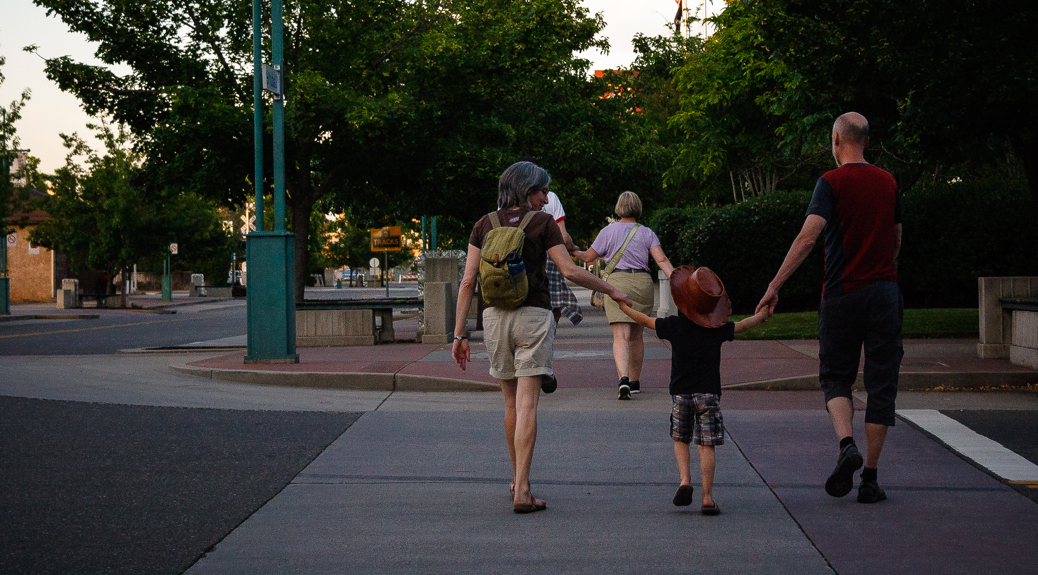The May 1 workshop, Best Foot Forward: Downtown Redding was a wonderful opportunity to gather people from across the community to discuss opportunities and solutions that could make a real difference in our community.
The California Walks and SafeTREC team developed a report to synthesize the conversations and recommendations. We want to share the report with you. It’s available here:
Report – Recommendations to Improve Pedestrian Safety in Downtown Redding
Workshop Presentation – Working Toward a Safe, Vibrant and Walkable Community
Redding Injury & Collision Data – Data for Redding
California Pedestrian Injury Data – California Injuries Data
The City of Redding was identified as a focus community for a Community Pedestrian Safety Training, in collaboration with Shasta Living Streets, based on resident interest in pedestrian safety and walkability, as well as recent and planned active transportation improvements in and around the downtown core.
Summary of the May 1 Workshop
Redding community members requested a workshop to 1) provide City staff, community organizations, and residents with a toolkit for promoting pedestrian safety and walkability to inform future comprehensive active transportation planning and improvement efforts; 2) foster an open and collaborative relationship between community groups, residents, and City agencies; and 3) develop consensus for pedestrian safety priorities and actionable next steps in downtown Redding.
The workshop was attended by 25 individuals representing a wide range of organizations and disciplines, as well as the community-at-large, including:
- Francie Sullivan, Mayor, City of Redding
- Missy McArthur, Vice Mayor, City of Redding; Board Member, Shasta Regional Transportation Agency; Redding Area Bus Authority Representative
- Kristen Schreder, Council Member, City of Redding; Board Member, Shasta Regional Transportation Agency
- Redding Department of Public Works
- Redding Police Department
- Downtown Redding Property Owners
- Downtown Redding Transportation Planning Consultants
- Shasta Living Streets
- Shasta County Department of Public Works
- Shasta County Regional Transportation Agency
- Shasta County Public Health / Healthy Shasta
- Shasta County Safe Routes to School Program
- Caltrans District 2
- Caltrans Headquarters
- Shasta Historical Society
- Downtown Business Owners
- Developers
- Trilogy Architecture
- Community Residents
Participant Recommendations
The group reached broad consensus on the following recommendations:
Establish Pedestrian-Friendly Speeds through Traffic Signal Timing: Participants unanimously agreed that traffic speeds in downtown Redding needed to be re-evaluated and retimed in order to achieve lower, pedestrian-friendly speeds (between 23-25 MPH)—particularly for California, Market, and Pine streets.
Create Safer Intersections with Curb Extensions & Pedestrian Signal Adjustments: Participants identified several low-cost priority strategies to improve safety for people walking and crossing at intersections, including: building curb extensions—including temporary ones—to reduce crossing distances and slow turning vehicles; improving pedestrian signal timing with automatic pedestrian recall adjustments and leading pedestrian intervals at peak hours at downtown intersections; and adopting a “daylighting” policy to restrict parking at intersections and near crosswalks. Participants supported temporary curb extensions that could be rolled out in the near-term to achieve significant pedestrian safety gains, with Market/Placer, Placer/California, and Pine/Yuba as high-need initial installation sites. Participants noted, however, that the City should also plan for the systematic conversion of any temporary curb extensions to permanent concrete curb extensions in the future.
Ensure Market Street Remains a Pedestrian-Priority Street: Participants broadly supported re- opening Market Street to vehicles with the caveat that Market Street must remain a pedestrian- priority street. Participants identified extremely low vehicle speeds (15 MPH or less) and providing pedestrian-scale amenities (seating, shade, etc.) as key strategies for maintaining Market Street’s commitment to being a pedestrian-oriented space. One group suggested opening cross streets across the Promenade as an alternative approach to re-establishing vehicle traffic on Market Street itself.
Provide Shade throughout Downtown: Participants identified the lack of shade as a large barrier for people walking and recommended that the City systematically plant additional shade trees and/or install shade structures throughout downtown and especially for the Market Street Promenade.
Explore Options for Downtown Parking Policy: Participants expressed interest in working with the City to reexamine the downtown area’s parking policy in order to encourage increased turnover through strategies such as variable pricing of on- and off-street parking; creation of a parking benefits district where collected parking fees would be reinvested in streetscape and safety improvements in the area where the fees are collected; and the establishment of a “park once” strategy for downtown.
Improve Downtown Walkability through Parklets, Wayfinding, & Lighting: Participants identified several strategies to improve downtown’s walkability, including exploring the establishment of temporary, voluntary “parklet” program; installing additional pedestrian-scale lighting; implementing pedestrian-scale wayfinding and signage throughout the downtown area; and improving the lighting and/or painting the ceiling of the central parking garage white to encourage more utilization of off-street parking as a park-once district strategy in the short- term.
MORE INFORMATION — See the report for an overview of safety conditions in downtown, complete input by the group, recommendations by the California Walks and SafeTREC team – and a complete list of all the people, businesses and organizations who contributed to this workshop and report.
Thank You to the many participants who gave their time, energy and expertise for this project. Thank You to the workshop presenters and facilitators: The California Walks and SafeTREC team and Cheryl Brinkman from San Francisco MTA.
And a very special Thank You! to Shasta Living Streets members, business sponsors and supporters whose contributions make projects like this possible. Thank You to the Northern C’s Cal Alumni Club our community partner for this project.

